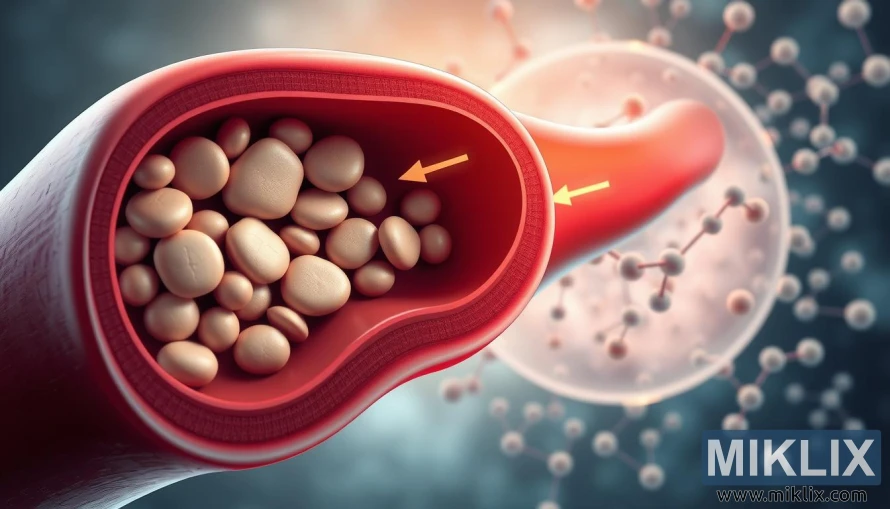Image: Cholesterol levels in artery cross-section
Published: June 23, 2025 at 2:14:40 PM UTC
Last updated: September 26, 2025 at 10:05:00 AM UTC
Detailed illustration of an artery with varying cholesterol deposits, blood flow, and molecular structures, highlighting cholesterol management.
The illustration presents a strikingly detailed visualization of cholesterol buildup within an artery, using a cross-sectional view to reveal what is often invisible to the naked eye. The artery is depicted as a cylindrical tube, sliced open to expose the inner workings of blood flow and the accumulating deposits that can compromise cardiovascular health. Inside the arterial wall, clusters of rounded, waxy particles represent cholesterol deposits, their smooth surfaces giving them an almost tangible weight and density. They press against the inner lining of the vessel, narrowing the pathway through which blood can flow. The narrowed lumen is highlighted by arrows indicating the movement of blood, a reminder that the flow is being forced through a restricted passage, signaling the potential danger of impaired circulation.
The smooth, reddish tones of the artery wall contrast with the pale, almost pearl-like cholesterol deposits, making the obstruction visually immediate and easy to understand. The layering of the arterial structure is carefully rendered, with the inner lining shown as a thin, delicate surface being stressed by the accumulating plaque. This tension between the body’s natural smooth pathways and the invasive buildup illustrates the gradual but harmful process that can lead to conditions such as atherosclerosis, heart disease, or stroke. The arrows guiding the viewer’s eye along the flow of blood create a sense of movement, subtly reinforcing the urgency of maintaining clear, healthy vessels for proper circulation.
In the background, the image transitions from a macro to a micro perspective, showing a molecular-level interpretation of cholesterol. Molecular structures, rendered as connected spheres and lines, hover in a diffuse, bluish glow, representing the chemical reality behind the visible deposits. This layering of perspectives—macro anatomical view in the foreground and micro chemical view in the background—provides a comprehensive understanding of cholesterol as both a structural presence in arteries and a biochemical entity with profound effects on human health. The soft lighting that surrounds these molecular forms enhances their three-dimensionality, giving the sense that they float in a scientific ether, bridging the gap between biology and chemistry.
The color palette blends naturalistic reds of living tissue with cooler scientific hues like blues and greys, striking a balance between realism and conceptual illustration. This careful use of color not only enhances visual clarity but also evokes the clinical setting in which cholesterol is studied, measured, and managed. The result is an image that feels both educational and cautionary, illuminating the silent process that can take place inside the body without symptoms until it reaches a critical stage.
Beyond its immediate scientific purpose, the image serves as a visual metaphor for the importance of balance within the body. Just as the artery must remain open and unobstructed for life-sustaining blood to flow, so too must lifestyle, diet, and medical care align to prevent the silent buildup of harmful plaque. It is an illustration that communicates both knowledge and warning, designed to make complex biological processes accessible and to underscore the stakes of cholesterol management in maintaining overall cardiovascular health.
The image is related to: From Salad Dressing to Daily Dose: Surprising Benefits of Apple Cider Vinegar Supplements

